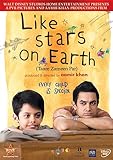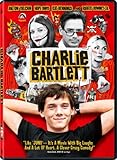Warning: The fast-moving blinking introductory sequence to this picture could trigger seizures or otherwise pose a problem for those with sensory issues.
 Like Stars on Earth is ostensibly about a small boy from India named Ishaan who has dyslexia, but from what is initially portrayed, he seems to have a larger problem with a wandering mind and very intense daydreaming, both in and out of class. However, this makes him a gifted artist, who is well above his age group in what he can draw and imagine. The movie says that he is 8 years old, but he actually looks much smaller than an eight-year old. While his older brother brags to his parents of his high marks, Ishaan tosses his test papers to the dogs, and tries to avoid talking about school.
Like Stars on Earth is ostensibly about a small boy from India named Ishaan who has dyslexia, but from what is initially portrayed, he seems to have a larger problem with a wandering mind and very intense daydreaming, both in and out of class. However, this makes him a gifted artist, who is well above his age group in what he can draw and imagine. The movie says that he is 8 years old, but he actually looks much smaller than an eight-year old. While his older brother brags to his parents of his high marks, Ishaan tosses his test papers to the dogs, and tries to avoid talking about school.
It is perhaps the structure and restrictions of the normal expectations of the school system that rub him the wrong way, because one day, after having been punished by being sent by the teacher to stand in the hallway, he goes AWOL and wanders the streets, savoring the exciting sights of tourist-film India. He appears to be somewhat hyperactive. If his parents attempted to have him tested, it may be that he never sat still long enough to get a diagnosis.
Everyone in Ishaan’s life complains about him, from the school bus driver, because he is constantly late and must be bodily pulled away from whatever he is doing when it is time to take the bus; to the teachers who see sub-par schoolwork and bad behavior, to the neighborhood kids who have no love for him because of his bad aim with a ball.
Things come to a head when he is busted by his parents for having forged an absence note to account for that day out of school. They have a meeting with his teachers and it is revealed that Ishaan is repeating the third grade, and his teachers tell his parents that there’s been no improvement the second time around. They suggest Ishaan’s parents send him to a “special school”, but Ishaan’s father believes that it is the class size of 60 and a perceived “lack of discipline” that has led to Ishaan’s academic failure. So he makes good on his repeated threat to send Ishaan to boarding school, where the teachers attempt to cure his wandering attention by rapping his hands with a ruler, his problems seeing letters “dancing” in front of him on book pages and blackboards and his academic failures continue.
Ishaan is clearly depressed by the above by the time the school gets a new art teacher, who makes a dramatic entrance with a song-and-dance routine, playing a flute and wearing a clown suit. (This movie has several Bollywood-inspired mini-music videos effectively portraying certain situations and emotions in compressed amounts of time. They are very well done and a bit more restrained than in some movies meant strictly for East Indian consumption. The DVD has a separate section of them so they can be played independently of the movie.)
The new, youngish, enthusiastic teacher brings with him a wave of fresh air and happiness which is apparent to all, but doesn’t immediately sweep over Ishaan. The new, youngish, enthusiastic teacher (who also teaches at one of those so-called “special schools”) must first discover that Ishaan has dyslexia, and tell his parents and the other teachers, and embark upon a program of academic remediation for Ishaan and consciousness-raising for his classmates.
Superteacher will in time also reveal that he, too, has dyslexia, of course. (“Special Ed kid makes good by growing up to be Special Ed teacher” is the theme of any number of children’s books and college essays in the US.)
I love where he tells Ishaan’s father that in the Solomon Islands, villagers don’t chop down a tree when they want to clear land, but curse and hurl abuses at it, and the tree withers and dies soon after. My mother, a Special Ed teacher in a US-based special school, said “I would get fired if I were to talk to a parent like that”. This picture is a revealing look at middle class life in India, the importance placed by the striving middle class of India on school performance, and the school system in India, which, as it turns out has “Education for All” legislation on the books similar to Special Education laws which came into existence in the US during the 1970s, but which more often than not fail to be implemented on the school level in India.
One bright spot in Ishaan’s boarding school experience is that he makes friends with Raju, a boy with heavy, old-style braces on his legs who recognizes his intelligence, and (fulfilling the stereotype about disabled kids) is more observant and accepting than the other kids in the class.
Ishaan is seen having letters traced into his forearm, writing abcs in a sand tray, molding letters out of clay. Whatever problems he may have been having in Hindi (a language formally studied in school and spoken in class by some of the teachers) are not portrayed in this movie, just notebooks with backwards letters and misspelled words in English. Math concepts were given in an interesting fashion: the teacher had Ishaan ascend higher steps on an outdoor stairway to instill the concept of increasing numbers by multiplication. (What to do for a kid with both dyslexia and mobility impairments, if such a kid exists?) While all of these tactile measures portrayed may contribute to “rewiring” a dyslexic child’s brain, and are recognized techniques in special education, the idea that a kid will inevitably experience a shining improvement soon thereafter may not be realistic. The evidence of his inevitable improvement is portrayed as better English writing and his demonstrated ability to read a poster announcing a school-wide art contest and sound out a complex, multi-syllabic word.
 Prep school student Charlie Bartlett is caught forging driver’s licenses and expelled yet again, setting him up for a transfer to public school and a prescription for Ritalin. Charlie ventures onto a school bus for presumably the first time, and encounters an overly friendly fellow who we are meant to consider intellectually challenged. (In a clear allusion to Of Mice and Men, the guy is named Len Arbuckle.)
Prep school student Charlie Bartlett is caught forging driver’s licenses and expelled yet again, setting him up for a transfer to public school and a prescription for Ritalin. Charlie ventures onto a school bus for presumably the first time, and encounters an overly friendly fellow who we are meant to consider intellectually challenged. (In a clear allusion to Of Mice and Men, the guy is named Len Arbuckle.) 


